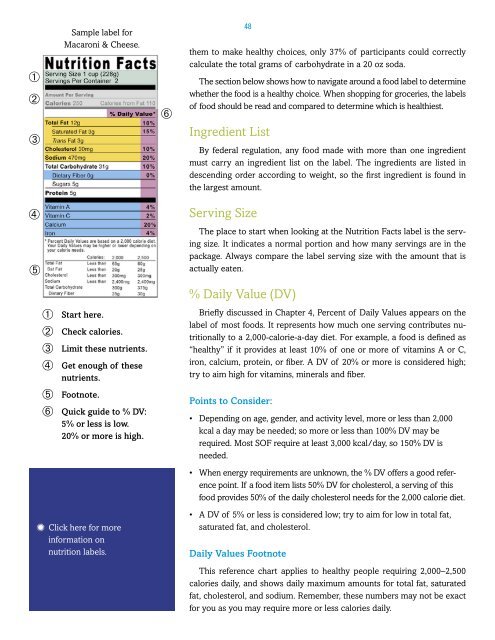special-operations-nutrition-guide
special-operations-nutrition-guide
special-operations-nutrition-guide
Create successful ePaper yourself
Turn your PDF publications into a flip-book with our unique Google optimized e-Paper software.
➀<br />
➁<br />
➂<br />
Sample label for<br />
Macaroni & Cheese.<br />
➅<br />
48<br />
them to make healthy choices, only 37% of participants could correctly<br />
calculate the total grams of carbohydrate in a 20 oz soda.<br />
The section below shows how to navigate around a food label to determine<br />
whether the food is a healthy choice. When shopping for groceries, the labels<br />
of food should be read and compared to determine which is healthiest.<br />
Ingredient List<br />
By federal regulation, any food made with more than one ingredient<br />
must carry an ingredient list on the label. The ingredients are listed in<br />
descending order according to weight, so the first ingredient is found in<br />
the largest amount.<br />
➃<br />
➄<br />
➀ Start here.<br />
➁ Check calories.<br />
➂ Limit these nutrients.<br />
➃ Get enough of these<br />
nutrients.<br />
➄ Footnote.<br />
➅ Quick <strong>guide</strong> to % DV:<br />
5% or less is low.<br />
20% or more is high.<br />
Serving Size<br />
The place to start when looking at the Nutrition Facts label is the serving<br />
size. It indicates a normal portion and how many servings are in the<br />
package. Always compare the label serving size with the amount that is<br />
actually eaten.<br />
% Daily Value (DV)<br />
Briefly discussed in Chapter 4, Percent of Daily Values appears on the<br />
label of most foods. It represents how much one serving contributes <strong>nutrition</strong>ally<br />
to a 2,000-calorie-a-day diet. For example, a food is defined as<br />
“healthy” if it provides at least 10% of one or more of vitamins A or C,<br />
iron, calcium, protein, or fiber. A DV of 20% or more is considered high;<br />
try to aim high for vitamins, minerals and fiber.<br />
Points to Consider:<br />
• Depending on age, gender, and activity level, more or less than 2,000<br />
kcal a day may be needed; so more or less than 100% DV may be<br />
required. Most SOF require at least 3,000 kcal/day, so 150% DV is<br />
needed.<br />
• When energy requirements are unknown, the % DV offers a good reference<br />
point. If a food item lists 50% DV for cholesterol, a serving of this<br />
food provides 50% of the daily cholesterol needs for the 2,000 calorie diet.<br />
==Click here for more<br />
information on<br />
<strong>nutrition</strong> labels.<br />
• A DV of 5% or less is considered low; try to aim for low in total fat,<br />
saturated fat, and cholesterol.<br />
Daily Values Footnote<br />
This reference chart applies to healthy people requiring 2,000–2,500<br />
calories daily, and shows daily maximum amounts for total fat, saturated<br />
fat, cholesterol, and sodium. Remember, these numbers may not be exact<br />
for you as you may require more or less calories daily.


